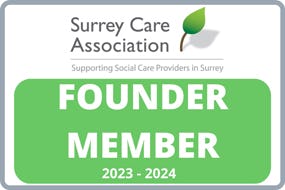Cerebral Palsy can affect a person’s posture, balance, communication skills, eating habits, learning development, sleeping patterns and much more. The severity differs from one case to another and is usually unique to the individual. Trinity Homecare has provided Cerebral Palsy care for over 25 years and offers a wealth of experience providing heartfelt care services for those who rely on us.
What is Cerebral Palsy?
Cerebral Palsy is an ‘umbrella’ term for a group of neurological disorders that permanently affect body movement and muscle coordination. Cerebral Palsy often appears in infancy or early childhood and affects balance and posture through abnormal damage or development in areas of the brain that control motor activity and muscle tone.
Cerebral Palsy Causes
The causes of Cerebral Palsy are usually through damage to certain areas of the developing brain. This damage can occur at different stages, but in most cases, extensive testing from a radiologist, neurologist or pediatric radiologist would be necessary to pinpoint the type of brain damage and the location of impairment. Cerebral Palsy causes can be from damage:
- When the brain is beginning to form during early pregnancy
- During birth
- In the first few years of life
Every case of Cerebral Palsy is unique to the individual. The causes of cerebral palsy are dictated by how the injury to the brain was acquired, the type of injury, the timing of the injury and the extent of the damage. The brain damage that causes Cerebral Palsy is a result of either:
- Prenatal disturbance of brain cells
- Prenatal hindrance of developing nerve cell fibres
- Perinatal death of brain cells
- Postnatal non-functional connections between synapses
Signs of Cerebral Palsy
The main signs include problems with movement, development and coordination. Possible Cerebral Palsy signs in a child include:
- Delays in reaching development milestones (eg: not walking by 18 months)
- Weak arms and legs
- Fidgety and clumsy movement
- Uncontrolled movement
- Seeming too stiff or too floppy (hypotonia)
- Shaking hands and tremors
- Muscle spasms
The areas of the body that Cerebral Palsy effects can also vary. Sometimes the entire body is affected, sometimes it’s the upper or lower half, and it can even impair only one side of the body. This is all dependent on the type of Cerebral Palsy that an individual faces.
Cerebral Palsy Symptoms
The symptoms of Cerebral Palsy are not usually obvious following the birth of a baby. Cerebral Palsy symptoms usually become noticeable during the first two to three years of a child’s life. These symptoms include, but are not limited to;
- Problems with speaking and communication
- Feeding and swallowing difficulties
- Seizures or fits (epilepsy)
- Difficulty falling asleep/staying asleep
- Constipation
- A curved spine (scoliosis)
- Abnormal hips that dislocate easily
- Urinary incontinence and difficulty controlling the bladder
- A learning disability
- Sight and hearing problems
The Types of Cerebral Palsy
Cerebral Palsy symptoms are often dictated by the type of Cerebral Palsy that the individual is suffering from. For a clear understanding of the causes and effects, Cerebral Palsy is broken down into four different types: Spastic, Athetoid, Ataxic and Mixed. The type of brain injury that a child acquires is the key influence behind the symptoms of Cerebral Palsy.
Spastic Cerebral Palsy
Spastic cerebral palsy makes up to 70-80% of Cerebral Palsy cases. This type of Cerebral Palsy is caused by damage to the Brain’s Motor Cortex which controls voluntary movement. This is the reason people with Spastic Cerebral Palsy often experience exaggerated and jerky movements, stiffness in the body, tightened joints and awkward reflexes.
Athetoid Cerebral Palsy
Around 10% of children with Cerebral Palsy are diagnosed with Athetoid Cerebral Palsy. This is caused by damage to the Basal Ganglia and/or Cerebellum. The Basal Ganglia is responsible for regulating voluntary motor functions and eye movements, while balance and co-ordination are directly impaired by damage to the Cerebellum. The main symptom is involuntary movement in the face, torso and limbs, making it difficult to perform everyday tasks.
Ataxic Cerebral Palsy
Ataxic Cerebral Palsy causes problems with voluntary movement, balance and coordination – though it only takes up a small percentage of cases. The primary cause is damage to the Cerebellum, which controls balance and coordination, this leads to tremors, difficulty speaking and reduced muscle tone amongst other potential symptoms.
Mixed Cerebral Palsy
Mixed Cerebral Palsy makes up less than 10% of all cases. In circumstances where damage to the brain cannot be confined to one location, this is labelled as Mixed Cerebral Palsy. In such circumstances, it is possible to face several Cerebral Palsy symptoms through a combination of brain injuries. The most common mixed diagnosis is a combination of Spastic and Athetoid Cerebral Palsy.
Cerebral Palsy Care
At Trinity Homecare, we have offered heartfelt Cerebral Palsy care for over 25 years. We know just how much of an impact a helping hand can make for those with Cerebral Palsy, reducing the challenges of day to day life. Having a dedicated TrinityCarer by your side can enrich your lifestyle by letting you do the things you love the most.
Trinity tailors bespoke Cerebral Palsy care plans directly around your needs to help you live happily and healthily. This will provide you with the exact amount of care you require, whether that be once a week, multiple times per day, or a full-time care companion to be there for you around the clock.
Contact us today to see how we can help you with personalised home care from the heart.









